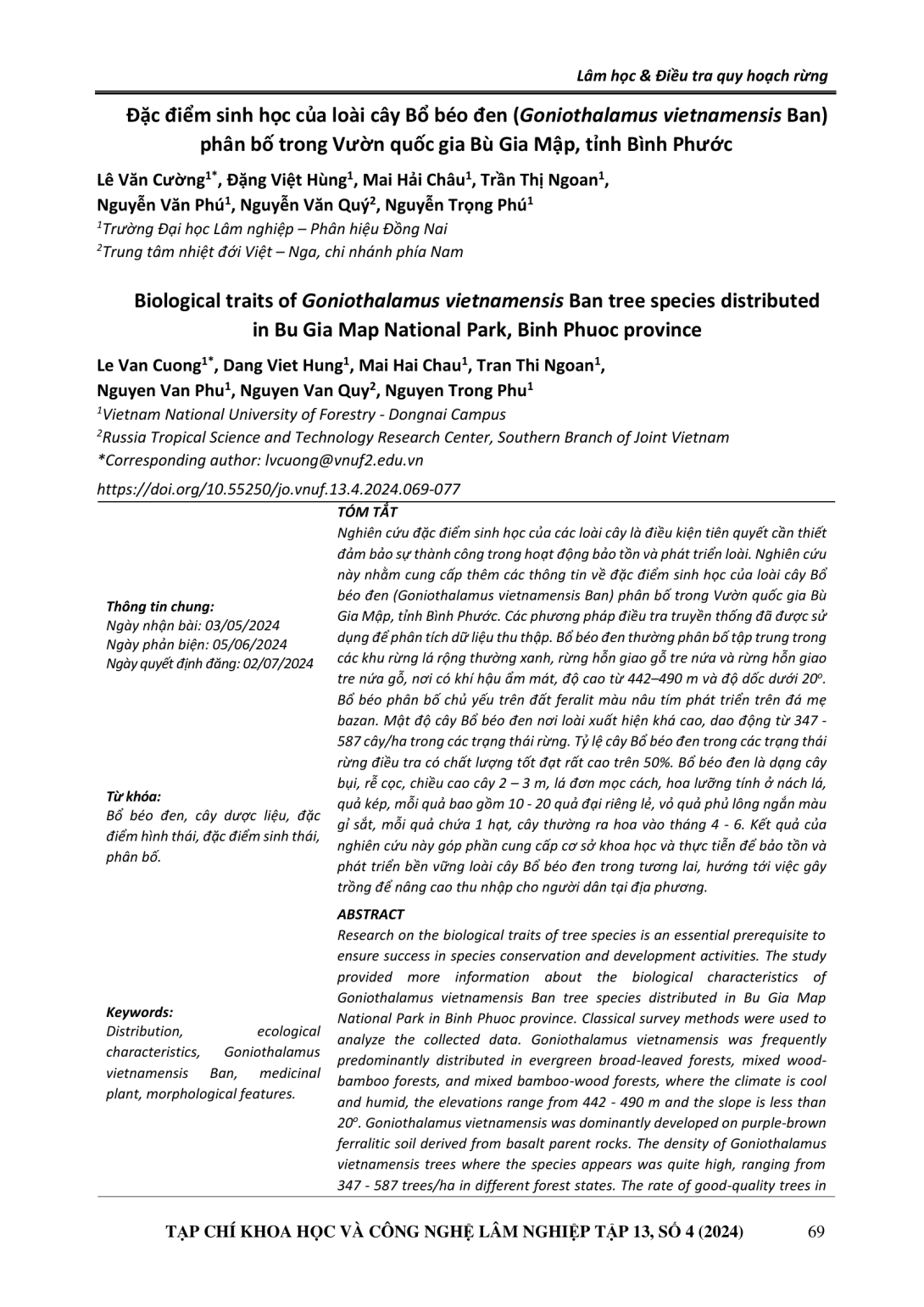
Nghiên cứu đặc điểm sinh học của các loài cây là điều kiện tiên quyết cần thiết đảm bảo sự thành công trong hoạt động bảo tồn và phát triển loài. Nghiên cứu này nhằm cung cấp thêm các thông tin về đặc điểm sinh học của loài cây Bổ béo đen (Goniothalamus vietnamensis Ban) phân bố trong Vườn quốc gia Bù Gia Mập, tỉnh Bình Phước. Các phương pháp điều tra truyền thống đã được sử dụng để phân tích dữ liệu thu thập. Bổ béo đen thường phân bố tập trung trong các khu rừng lá rộng thường xanh, rừng hỗn giao gỗ tre nứa và rừng hỗn giao tre nứa gỗ, nơi có khí hậu ẩm mát, độ cao từ 442–490 m và độ dốc dưới 20o. Bổ béo phân bố chủ yếu trên đất feralit màu nâu tím phát triển trên đá mẹ bazan. Mật độ cây Bổ béo đen nơi loài xuất hiện khá cao, dao động từ 347 - 587 cây/ha trong các trạng thái rừng. Tỷ lệ cây Bổ béo đen trong các trạng thái rừng điều tra có chất lượng tốt đạt rất cao trên 50%. Bổ béo đen là dạng cây bụi, rễ cọc, chiều cao cây 2 – 3 m, lá đơn mọc cách, hoa lưỡng tính ở nách lá, quả kép, mỗi quả bao gồm 10 - 20 quả đại riêng lẻ, vỏ quả phủ lông ngắn màu gỉ sắt, mỗi quả chứa 1 hạt, cây thường ra hoa vào tháng 4 - 6. Kết quả của nghiên cứu này góp phần cung cấp cơ sở khoa học và thực tiễn để bảo tồn và phát triển bền vững loài cây Bổ béo đen trong tương lai, hướng tới việc gây trồng để nâng cao thu nhập cho người dân tại địa phương.
Research on the biological traits of tree species is an essential prerequisite to ensure success in species conservation and development activities. The study provided more information about the biological characteristics of Goniothalamus vietnamensis Ban tree species distributed in Bu Gia Map National Park in Binh Phuoc province. Classical survey methods were used to analyze the collected data. Goniothalamus vietnamensis was frequently predominantly distributed in evergreen broad-leaved forests, mixed woodbamboo forests, and mixed bamboo-wood forests, where the climate is cool and humid, the elevations range from 442 - 490 m and the slope is less than 20o. Goniothalamus vietnamensis was dominantly developed on purple-brown ferralitic soil derived from basalt parent rocks. The density of Goniothalamus vietnamensis trees where the species appears was quite high, ranging from 347 - 587 trees/ha in different forest states. The rate of good-quality trees in the investigated forest states was very high (over 50%). Goniothalamus vietnamensis is a shrub with tap roots, 2 – 3 m high, single leaves growing apart, bisexual flowers at leaf axils, and compound fruits, each consisting of 10 - 20 individual, fruit covered in short rust-colored hairs, each fruit contains 1 seed, the tree typically bloom in April-June. The results of this study contribute to providing a scientific and practical basis for the future conservation and sustainable development of the Goniothalamus vietnamensis tree, aiming at planting to increase income and improve local people's lives.
- Đăng nhập để gửi ý kiến
